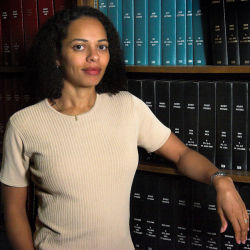
In 1986, Nadya Mason competed as a gymnast in Houston, training with the legendary Bela Karolyi as a member of the U.S. National Team, hoping to make it to the Olympics. She never did.
But, 23 years later, as Doctor Nadya Mason, an assistant professor of physics at the University of Illinois at Urbana-Champaign, she did win the Microsoft-sponsored 2009 Denice Denton Emerging Leader Award. It’s an honor bestowed by the Anita Borg Institute for Women and Technology "to someone in a junior, un-tenured, faculty position under the age of 40 who is pursuing high-quality research and, at the same time, is contributing significantly to promote diversity in their environment," says Deanna Kosaraju, vice president of programs at the Institute.
Apparently still in motion, Mason has become somewhat of a celebrity within both scientific and humanitarian circles — as well as "a star" in a YouTube profile.
"As a woman, as a black woman, Dr. Mason is passionate about the diversity issues that affect the scientific community," says Dale J. Van Harlingen, a collaborator and the head of her department. "But, just as importantly, she’s an exceptional scientist working in a field that lots of people are interested in."
That field concerns what happens to the properties of materials when one makes objects, such as computers, very small. At some point in the shrinking process, the computer’s parts get so tiny they don’t behave the same way they did when they were larger. Her goal is to figure out why.
"For example," she explains, "we work with carbon nanotubes that are just one-billionth of a meter in diameter but up to centimeters long; think of them as the tiniest wires you can make. What sort of electronic behavior can you expect from something only a few atoms across? Is it just what you’d expect from a bigger wire — or does something different happen? The answer is that something different happens . . . which, I would think, would be very relevant to the computer industry which has a stake in making computers keep working no matter how small they get.
"And," she asks hypothetically, "can we harness quantum mechanics itself to make a quantum computer that can calculate more powerfully than any classical computer?"
While Mason is engaged in "pure research," she is also collaborating on campus with people who are interested "in commercializing such research," Van Harlingen says.
"Ultimately, what people have in mind is a whole technology of low-dimensional, single-molecule electronics which enables the production of extremely small graphene or nanotube devices that can actually perform the same functions that transistors do now," he says. "It’s all still in the very early stages, but people do see this as an alternate route to computing."
Paul Hyman was editor-in-chief of several hi-tech publications at CMP Media, including Electronic Buyers’ News.



Join the Discussion (0)
Become a Member or Sign In to Post a Comment